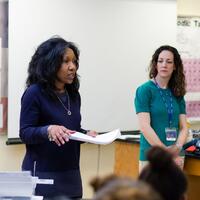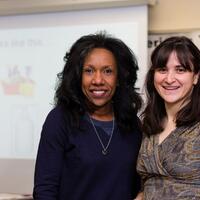Combating Everyday Chemical Exposures through Hands-on Environmental Health Curriculum, a Mobile App, and Peer to Peer Mentoring
Project Details
Year: 2018
Location: Newton
Project Manager: Dr. Jennifer Liss Ohayon, Silent Spring, and Michelle Dixon, MBCC
Partners:
Overview
Silent Spring Institute and the Massachusetts Breast Cancer Coalition (MBCC) partnered on a project to reduce high school students’ exposures to common carcinogens, endocrine‐disrupting chemicals, and asthmagens. The project team visited 8 high school science classrooms across Massachusetts to help students identify common toxic chemical exposures in their homes and adopt strategies that reduce these exposures. The team did this through hands-on curriculum and Silent Spring’s free mobile app Detox Me that guides users through more than 270 research‐based recommendations for reducing exposures to common indoor pollutants. Students also participated in a peer‐to‐peer mentoring program connecting them to youth at the Center for Environmental Research and Children’s Health at the University of California, Berkeley who participated in environmental health research and afterwards took action to prevent toxic exposures in their homes and communities.
Accomplishments
- Developed and implemented a two class curriculum in six Massachusetts High Schools
- Roxbury Latin School
- Boston Latin Academy
- Drury High School (North Adams)
- Dennis-Yarmouth High School
- Barnstable High School
- Chapel Hill-Chauncey Hall School (Waltham)
- Over 140 students participated
- An addition 150 students were reached at lecture hall presentations at two additional schools
- Students implemented surveys of household and personal care products at home and graphed their household chemical exposure
- Students reduced toxic exposures using Silent Spring's smartphone app, Detox Me (which includes 270 research based recommendations for safer alternatives)
- Massachusetts students connected to youth participants in biomonitoring research at UC-Berkeley to share information
The team evaluated the project using analytics from the app and student reports. Most students communicated during classroom discussions that this was their first time learning about environmental health. While there was a varied level of exposure to the endocrine system in high school curriculums (often dependent on grade level and private versus public schools), almost no students had learned about endocrine disrupting chemicals prior to our visit.
To help evaluate participation and behavior shifts, the team tracked app usage for 129 students (the team engaged well over 140 students in the classroom activities, but some students did not have smartphones- they received handouts with printed app tips). Students were asked to use the app for two weeks and try to complete at least five tips. Students averaged five sessions of visiting the app. Students viewed a large portion of tips in the app (98 on average) and often completed more than were assigned (11 tips on average). 13% of students shared the app with their peers through the app’s sharing feature.
As part of the curriculum, students also wrote reports about what they learned, what tips they adopted, and any challenges that they faced. Reports also emphasized that this was their first introduction to this type of material, and many communicated that they found the exposure reduction tips easy to implement and would continue with them.
This page updated Thursday July 26 2018


